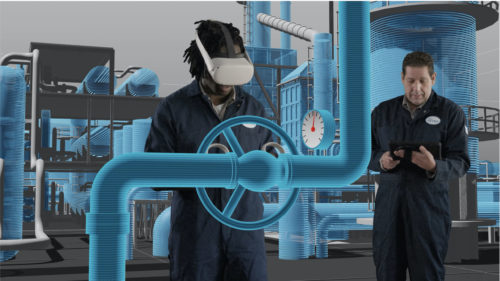Two essential smart factory transformation components
Smart factory transformation is the future. If you can’t create a relationship between people and devices, you’ll be left behind.
Smart cars, smartphones, smart devices of all shapes and sizes — they’re great, but what we really need is smart people.
Luckily, that’s exactly the idea smart factory initiatives are built on. While tools like artificial intelligence, automation and sensors can be useful, the element that really puts the “smart” in “smart manufacturing” is you and your people.
No amount of robots and smart devices can make up for the value your workforce brings to the manufacturing process. At its best, a smart factory is a well-structured relationship between people and technology.
So how do you build that relationship? Simple: Start by building your smart factory implementation around prioritization and prescription.
Is smart manufacturing really the future?
Before we take a closer look at prioritization and prescription, let’s get one thing out of the way: Smart factory transformation is the future of manufacturing.
That’s a big claim to make, but it’s true. If you can’t create this strategic relationship between people and devices, you’ll be left behind as other manufacturers realize all the benefits of smart technology and digital transformation — and that’s something you simply can’t afford.
But don’t take our word for it. Here are a few examples of how smart manufacturing is helping shape, inform, and even manifest the future:
Improving the production process
As manufacturers, we’re always looking for ways to improve. Smart manufacturing makes that possible by gathering data you never had access to in the past. Better yet, it helps you analyze that data in ways that support production improvements. That means you no longer have to guess what the next best step is going to be — you’ll have tools, systems and even machine learning to help you plan your decisions.
Updating best practices
You could improve the production process until it’s literally perfect (hey, we can dream, right?), but even that wouldn’t make a difference if there’s no way to repeat those improvements or share them with the rest of the organization. That would result in a lot of wasted time, effort and money as you make changes and fail to learn from them.
The good news is that the future is all about data — and so is smart manufacturing. Smart factory technology turns your improvements into data that can be shared across the plant, the organization and maybe even the world.
Using devices in smart ways
It’s not enough to get your hands on smart devices. That quickly becomes tech for tech’s sake, which isn’t very smart at all. Instead, you need to focus on getting the right devices and using them in the right ways. That’s what positions digital transformation as the future of the manufacturing industry: A smart factory is all about identifying when tech is necessary, which devices get the job done and how to implement them in ways that just make sense.
Keeping up with customers
It’s customer expectations that keep the supply chain on its toes. Luckily, smart manufacturing arms users with the tools necessary to adapt to change, upgrade each production process as necessary, learn from your own data and generally stay on the cutting edge of the manufacturing world. It’s your way of navigating whatever customers can throw at you.
Two things a smart factory needs (and three more it might appreciate)
Remember, the biggest thing your smart factory needs is people, including you. But let’s not get too big-headed here — even you need some help to get this relationship up and running.
Here are two things your smart factory needs, and three it might benefit from further down the line:
1. Prioritization
The first step in any smart manufacturing transformation is to prioritize. If you skip this part, you won’t know what your production process actually needs, which means rather than resolving the real issues impacting your bottom line, you’ll be solving the most visible problems, or catering to the “squeakiest wheels” and hoping for the best.
That’s why you need to know just how to narrow your focus — and to do that, you need visibility. With proper visibility, you can decide where to integrate which devices, when to invest in sensors and what goals you’re working toward.
This, of course, brings us right back to data, which is the foundation for visibility. You need to be able to capture data from multiple sources on the plant floor, store that data in a central repository, share it across the organization and — perhaps most importantly — use it to create a single version of the truth. Once you’ve done that, you can start prioritizing and making plans for the future — your future.
2. Prescription
If the first step in smart factory initiatives is having the visibility necessary to prioritize issues and tackle things in a logical order, then prescribing a solution to those issues is the natural next step. Coincidentally, it’s also the other essential component of a smart factory transformation.
This is where all that data really becomes your north star. By giving you insight into previous patterns and production failures, your data can tell you how to proceed. That might include the utilization of artificial intelligence, robots or other smart devices, or it might just be a small yet powerful improvement in how your teams handle a certain process.
As long as you’re doing the right things (prescription) in the right order (prioritization), your smart factory transformation will have the smarts it needs.
3. Integration
In some cases, those two essential components might need a little support from other solutions. One such example is integration.
Keep in mind that integration isn’t always necessary. It depends on the problem you’re facing and the solutions prescribed to address it — but if you find that integration is the way to go, remember to manage the process carefully. Only integrate the systems and data you need to proceed; otherwise, you might be wasting time herding all your cats when one or two would suffice.
In short, devices and integration are great, but only to the degree that they solve real, targeted problems.
4. Prediction
Prediction certainly sounds like the future, so why isn’t it one of the essential components of smart factory transformation?
In reality, everything beyond prioritization and prescription becomes conditional. The requirement for tools like prediction depends on the unique mix of challenges each manufacturer faces. Your data might not clearly tell you that prediction is the way to go; in fact, if the cost of predicting certain problems is higher than just dealing with those problems when they arise, your data is probably telling you to move on.
The key takeaway here is to focus on prioritization and prescription. Beyond that, keep your strategy pragmatic and use two guard rails to keep you on the right track: data and return on investment (ROI).
5. Automation
Automation is another tool you might expect to be critical in the future of manufacturing, but as with integration and prediction, that’s not always the case. (It also means robots aren’t stealing our jobs any time soon, so that’s good news.)
It’s far more important to be flexible than to grab automation solutions left and right. Sure, you should be ready to put robotics, or artificial intelligence to work when it benefits you — but if the costs outweigh the ROI, don’t bother. Just focus on creating that solid relationship between you and the devices you do need.
The foundation for smart factory transformation
Speaking of that relationship, how can you start building it? What’s the foundation for prioritization and prescription, the basis for every good smart factory transformation? A smart manufacturing platform.
A smart manufacturing platform is like pouring the concrete base upon which your entire smart factory will be built. It helps you get the most out of your time, money, energy, devices and creativity, making sure every element is pushing in the same direction.
Here are just a few ways a smart platform can make all the difference in your transformation:
1. Organization
Your smart manufacturing transformation will have a lot of moving parts — literally and figuratively. To keep all those parts moving in harmony, a smart manufacturing platform acts as a digital workspace where you can control and oversee various elements of your plant. Better yet, workers at all levels can interact with the platform, which means you’ll have insight into your entire factory.
2. Data visibility
One of the key features of a smart manufacturing platform is its ability to make data visible, accessible, and easy to utilize. Without this element, prioritization and prescription would be all but impossible, and your transformation would likely fall flat.
A Smart Manufacturing Platform should also make it easier to capture this data. That way, you know you’re seeing a complete, accurate picture when it comes time to make decisions about your future.
3. Improvement frameworks
Remember what we said about improvements having very little impact if you can’t share or repeat them? Well, a smart manufacturing platform helps you overcome this challenge by offering frameworks for improvement. Once you discover a better way of doing things — which you will, because that’s what a human/tech relationship is all about — you’ll be able to identify the specific problem they solved and which other areas could benefit. After repeating the new best practice a few times to make sure it’s really a best practice, you can share it with other locations in your organization to maximize your benefits.
4. Progress measurement
A smart manufacturing platform can’t just make promises. It has to actually follow through — and to make sure this software is holding up its end of the bargain, you need tools for progress measurement. Naturally, that’s mostly about data.
Because data tells the story of every manufacturing process, machine breakdown, sensor placement and production improvement, it’s just the benchmark you need to measure progress. With this information at your fingertips, it’s much easier to identify what success looks like for you — and to build your plant’s future around that vision.
– L2L is a CFE Media and Technology content partner.
Original content can be found at Leading2Lean.
Do you have experience and expertise with the topics mentioned in this content? You should consider contributing to our CFE Media editorial team and getting the recognition you and your company deserve. Click here to start this process.






